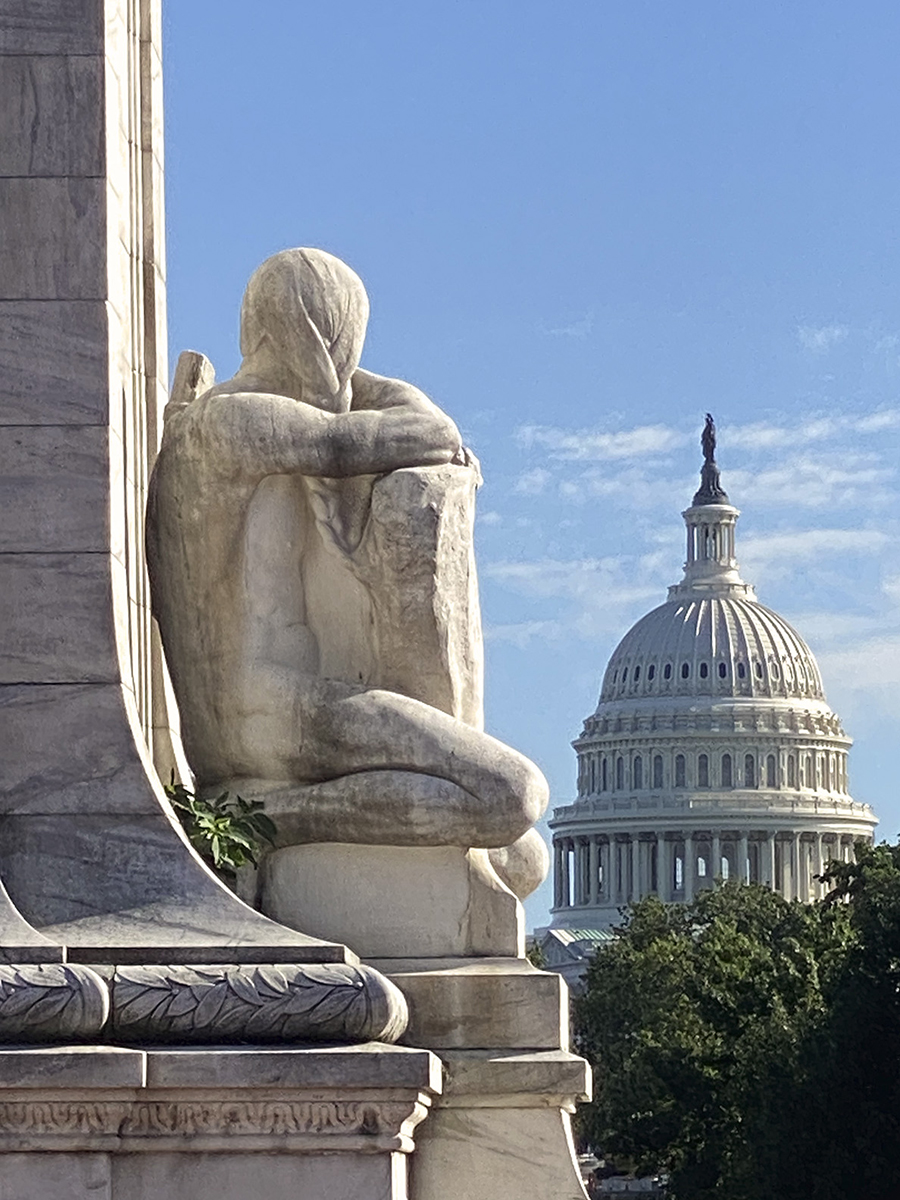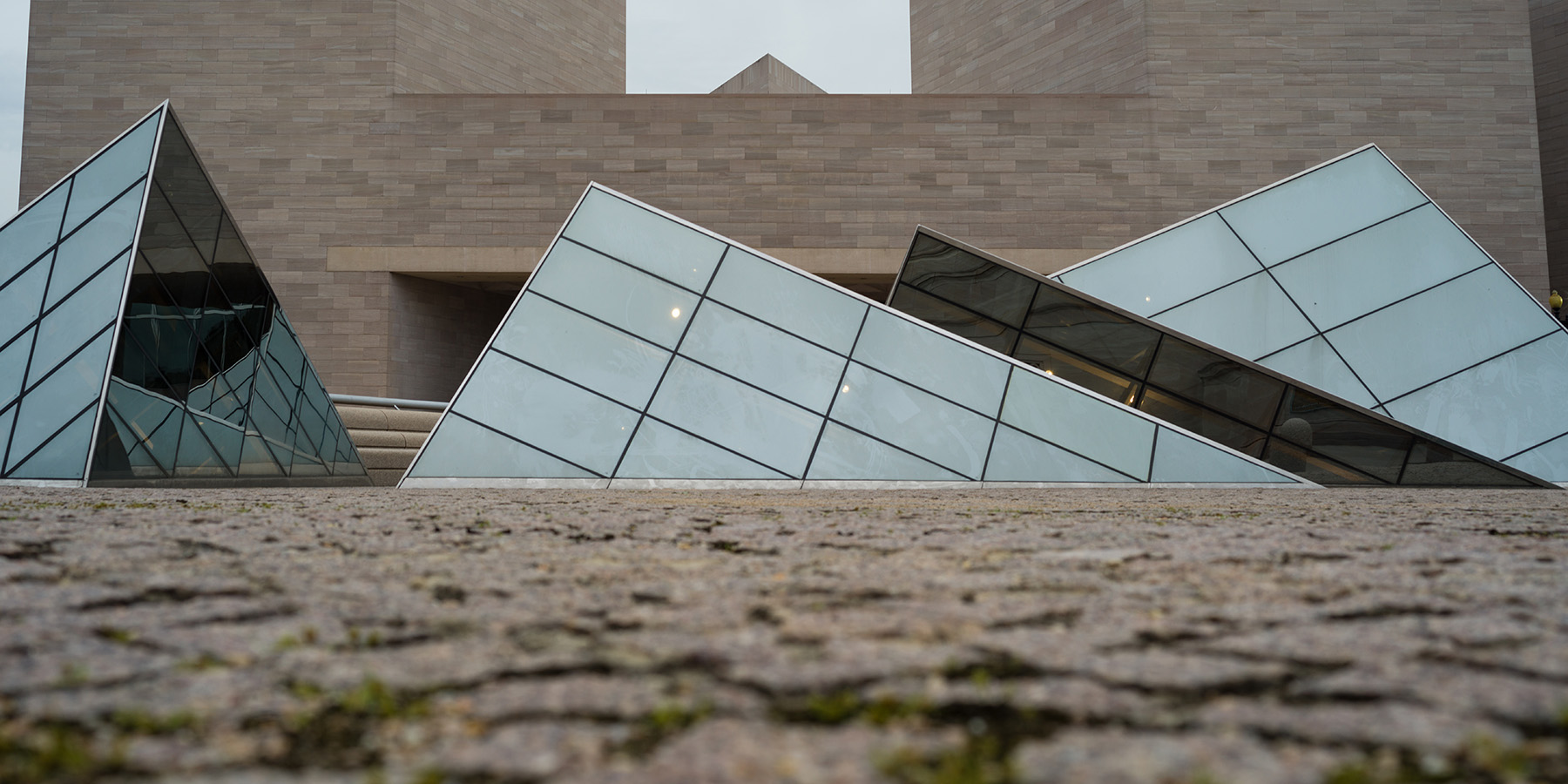Al-An deSouza
The National Mall in Washington, DC, as Imagined Nation

Al-An deSouza, Columbus Memorial, Union Station, Washington DC: Lorado Taft, 1912, Native American Figure Gazing at Statue of Freedom, Thomas Crawford, installed 1863, Capitol Building, from the Cross Eyed series, 2022, digital photograph
My research on ideologies of American landscape photography and painting is geared toward two closely linked outcomes: an art practice working with photo media and issues of memory and diasporic landscape, and a pedagogical practice including the development of an anti-racist curriculum.
The National Mall, one of the country’s most visited national parks, serves as the United States’ portrayal of historical memory and cultural aspirations. There is much to be gained by considering its urban design and the architecture of its museum buildings, as well as their collections and temporary exhibitions. Further, if we look at museum layouts, exhibition designs, and the juxtapositions of images/objects as curated and cultivated spaces, we encounter both intentional and unintentional narratives. These investigations provide “snapshots” of American culture at a particular time and place.
Thinking through social and cultural landscapes, we are introduced to conflicting imaginings of America, as situated within global histories and cultures. As such, landscapes can be approached as aesthetic regimes imag(in)ing the organization of social space: places of freedom, pleasure, escape, knowledge, and dominion, as well as an idyll or utopia, and/or as systems of hierarchy, containment, and control. Additionally, space and place can be addressed as issues of emplacement, displacement, and replacement.

Al-An deSouza, The National Gallery, Washington DC: Naiad, Antonio Canova, 1820–1823, marble, gazing across Ntozakhe II, (Parktown), Zanele Muholi, 2016, digital mural from photograph, from the Cross Eyed series, 2022, digital photograph
After completing my residency at the Center, I decided to propose a model for an introductory undergraduate course inspired by my experience of Washington, DC, and which would address some of the following themes.
- Consider the capital’s urban design and classical architecture as a set of contested societal ideals. Reflect, for example, on one’s arrival by train at Union Station, with its Roman-inspired architecture, including 46 statues of ancient legionnaires. Further examples might include the Capitol’s rotunda, dome, and National Statuary Hall as idealizations of democracy and empire—formulated through slavery. Especially in our current political moment, what effect do such monuments and buildings have upon our bodies, psyches, and aspirations? How do they foster a sense of collectivity and inclusion (for a community or a nation), or of division and exclusion?
- Contemplate how 19th-century ideas of European (neo)classicism were transformed by American landscape painting and architecture—specifically the work of Robert Seldon Duncanson, Thomas Cole, and the Hudson River School—with their visual vocabularies of immigration, expansion, and settlement coupled with the displacement, erasure, and historical rewriting of Indigeneity. These concepts may be considered in relation to the architecture and displays at the world’s fairs in Chicago (1893), Saint Louis (1904), and San Francisco (1915).
- Think through alternative American perspectives, as may be seen at the National Museum of the American Indian and National Museum of African American History and Culture, museums that offer contradictions to and critiques of dominant narratives, as well as assertions of historical and contemporary Native American and African American presence. Expand this consideration to alternative global histories found in the permanent collections and exhibitions at the National Museum of African Art and the National Museum of Asian Art.
- Gain awareness of modernism, postmodernism, and the contemporary (compared with colonialism, postcolonialism, and decoloniality), including their time lines. This introductory overview should emphasize that modernisms occur—sometimes simultaneously—in different parts of the world to create multiple, intersecting pathways engaged with global, contemporary art.
- Explore the National Gallery’s collections, from European to American art—its inclusions, exclusions, appropriations, and “hauntings” by the materials, cultures, and labor of those denied self-representation.
- Probe historical reframings such as Afro-Atlantic Histories, The Woman in White: Joanna Hiffernan and James McNeill Whistler, and American Silence: The Photographs of Robert Adams. These three overlapping exhibitions, presented at the National Gallery of Art in 2022, further discussions on the depiction and omission of racialized, sexualized, gendered, and classed subjects within framings of slavery, frontier, empire, and their aftermaths.
- Reflect on craft versus art at the Renwick Gallery of the Smithsonian American Art Museum, particularly its current exhibition This Present Moment: Crafting a Better World (2022–2023). Rather than any viable separation between craft and art, we consider the crafts of art-making, with emphases on materiality and the various skills employed to bring forth material properties, further addressing possibilities of representation and activation (or activism).
- Interrogate the Hirshhorn Museum and Sculpture Garden, its simultaneous or overlapping exhibitions as world-building landscapes addressing issues and methods within contemporary art, looking in particular at the work of Laurie Anderson, Mark Bradford, Sam Gilliam, Barbara Kruger, Yayoi Kusama, and Nicolas Party.
University of California, Berkeley
Paul Mellon Visiting Senior Fellow, summer 2022
Al-An deSouza returns to teaching duties as professor in the Art Practice Department at the University of California, Berkeley, having completed two three-year terms as department chair. They have been awarded a yearlong 2023 Poetry and the Senses Fellowship through the Arts Research Center at Berkeley.
